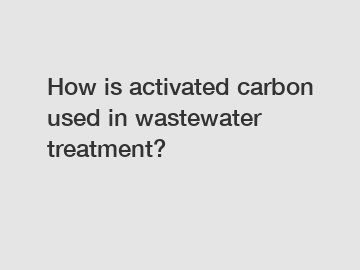How is activated carbon used in wastewater treatment?
How is activated carbon used in wastewater treatment?
Wastewater treatment plays a crucial role in maintaining the cleanliness and safety of our water resources. One key component of wastewater treatment is the use of activated carbon, which has proven to be highly effective in removing contaminants from water. This article will explore the various ways in which activated carbon is utilized in wastewater treatment processes and highlight its importance in keeping our water sources clean.
Activated carbon, also known as activated charcoal, is a highly porous form of carbon that has a large surface area and a unique ability to adsorb or trap impurities. It is produced by heating carbonaceous materials such as coal, wood, or coconut shells at high temperatures to create a network of pores and increase its adsorptive properties. The resulting activated carbon is widely used in many industries for purification and filtration purposes.

2. Adsorption Process.
Activated carbon works by the process of adsorption, where contaminants are physically trapped on the surface of the carbon particles. The porous structure of activated carbon provides a large surface area for impurities to adhere to, effectively removing them from the water. This process can remove a wide range of contaminants, including organic compounds, heavy metals, and odor-causing substances.
3. Removal of Organic Compounds.
One of the primary uses of activated carbon in wastewater treatment is the removal of organic compounds. These compounds can be found in various industrial effluents and sewage, posing a significant threat to water quality. Activated carbon effectively adsorbs organic molecules, such as pesticides, pharmaceuticals, and synthetic chemicals, reducing their concentration in the water and preventing their harmful effects.
4. Heavy Metal Removal.
Activated carbon is also highly effective in removing heavy metals from wastewater. Industrial processes, such as mining, metal plating, and chemical manufacturing, can contribute to the contamination of water with toxic metals like lead, mercury, and cadmium. The porous structure of activated carbon traps these heavy metals, preventing their release into the environment and safeguarding human and aquatic health.
5. Odor Control.
Another crucial aspect of wastewater treatment is the control of unpleasant odors caused by organic compounds. Activated carbon is extensively used to remove odor-causing substances, such as volatile organic compounds (VOCs) and sulfides, from wastewater. By adsorbing these odor molecules, activated carbon helps eliminate foul smells and improves the overall quality of treated water.
6. Final Polishing.
In the final stages of wastewater treatment, activated carbon is often employed as a polishing step. After primary and secondary treatment processes, trace amounts of contaminants may still remain in the water. Activated carbon acts as a final barrier, adsorbing any residual impurities and ensuring that the treated water meets the required quality standards before being discharged back into the environment.
Closing paragraph:
In conclusion, activated carbon plays a vital role in wastewater treatment by effectively removing organic compounds, heavy metals, and unpleasant odors from water sources. Its adsorptive properties and large surface area make it an excellent choice for water treatment facilities worldwide. If you have any questions about the use of activated carbon in wastewater treatment or would like to explore its application in your specific industry, please do not hesitate to contact us. We are here to assist you in maintaining the cleanliness and safety of our valuable water resources.
For more filter bag manufacturer, air filter photocatalyst, Water purification photocatalyst filterinformation, please contact us. We will provide professional answers.


